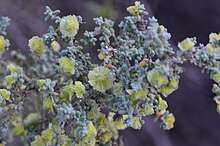Maireana pyramidata
Maireana pyramidata (sago bush,[5] black bluebush, shrubby bluebush[6]) is a species of plant within the genus, Maireana, in the family Amaranthaceae. It is endemic to Australia, and widespread throughout Australia in the inland, where it is found in Victoria, New South Wales, Queensland, the Northern Territory and Western Australia.[7][8][6][5][1]
| Maireana pyramidata | |
|---|---|
 | |
| Maireana pyramidata (fruit) | |
| Scientific classification | |
| Kingdom: | Plantae |
| Clade: | Tracheophytes |
| Clade: | Angiosperms |
| Clade: | Eudicots |
| Order: | Caryophyllales |
| Family: | Amaranthaceae |
| Genus: | Maireana |
| Species: | M. pyramidata |
| Binomial name | |
| Maireana pyramidata | |
 | |
| Occurrence data for M. pyramidata from the AVH | |
| Synonyms | |
Description
Maireana pyramidata is a low, dense, stiffly branched shrub of a height from 0.3 to 1.5 m,[8][5] with finely woolly branches.[5] It is both dioecious and unisexual.[6][5] The leaves are alternate, narrowly cylindrical[5] and covered with a mixture of dendritic (tree-like structure) and simple hairs.[5] It fruits from August to November.[5]
Distribution
It is widespread in drier areas, growing on calcareous soils, saline flats, salt lakes, on areas usually prone to flooding.[5][6][8] In Victoria, it is found in the far north-west: Mildura, Red Cliffs, Lake Culluleraine and Kerang-Swan Hill.[5]
In Western Australia, it is found in the IBRA regions of Avon Wheatbelt, Carnarvon, Coolgardie, Gascoyne, Gibson Desert, Great Sandy Desert, Great Victoria Desert, Little Sandy Desert, Murchison, Nullarbor, Pilbara, and Yalgoo.[8]
In New South Wales it is found in the subdivisions: NWP, SWP, NFWP, SFWP.[6]
Taxonomy and naming
It was first described by Bentham in 1870 as Kochia pyramidata,[3][9] with the type said to have been collected on the Lachlan River by Alan Cunningham in sand hill country.[10] (A syntype is MEL 0044017A.[11]) The species was reassigned to the genus Maireana by Wilson in 1975.[3][2]
The specific epithet, pyramidata, refers to the pyramidal shape of the centre of the fruit.[12]
References
- "NTFlora factsheet: Maireana pyramidata". Northern Territory Government. 2013. Retrieved 7 July 2018.
- Wilson, P.G. 1975. A Taxonomic Revision of the genus Maireana (Chenopodiaceae). Nuytsia 2(1): 41, fig. 10 A-B
- "Australian Plant Name Index (APNI): Maireana pyramidata". IBIS database. Centre for Plant Biodiversity Research, Australian Government, Canberra. Retrieved 13 May 2018.
- Govaerts, R. et.al. 2018. "Plants of the World online: Maireana pyramidata (synonyms)". Board of Trustees of the Royal Botanic Gardens, Kew. Retrieved 13 May 2018.
- "VicFlora: Maireana pyramidata". Royal Botanic Gardens, Foundation Victoria. Retrieved 13 May 2018.
- Jacobs, S.W.L. 1990. "Maireana pyramidata". PlantNET – FloraOnline. National Herbarium of NSW. Retrieved 13 May 2018.
- "AVH: Maireana pyramidata (mapview), Australasian Virtual Herbarium". Council of Heads of Australasian Herbaria. Retrieved 13 May 2018.
- "FloraBase: Maireana pyramidata". Western Australian Herbarium, Biodiversity and Conservation Science, Department of Biodiversity, Conservation and Attractions. Retrieved 13 May 2018.
- Bentham, G. 1870. Flora Australiensis 5: 186
- "Australian Plant Name Index (APNI): Kochia pyramidata". IBIS database. Centre for Plant Biodiversity Research, Australian Government, Canberra. Retrieved 13 May 2018.
- "AVH: Maireana pyramidata (MEL 0044017A), Australasian Virtual Herbarium". Council of Heads of Australasian Herbaria. Retrieved 13 May 2018.
- Moore, P (2005) A Guide to Plants of Inland Australia. Reed New Holland: Sydney.
External links
| Wikimedia Commons has media related to Maireana pyramidata. |
| Wikispecies has information related to Maireana pyramidata |
